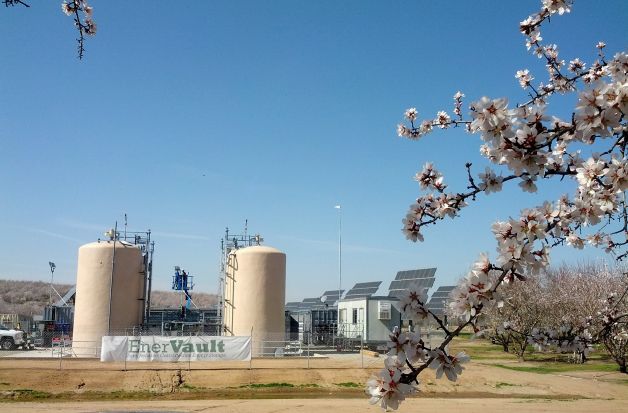forum
library
tutorial
contact

EnerVault Unveils 'Flow Battery'
for Solar Energy Storage
by David R. Baker
San Francisco Chronicle, May 22, 2014
|
the film forum library tutorial contact |

|
EnerVault Unveils 'Flow Battery'
by David R. Baker
|
 In an almond orchard outside Turlock in the Central Valley, two large tanks hold water, minerals - and more importantly, energy.
In an almond orchard outside Turlock in the Central Valley, two large tanks hold water, minerals - and more importantly, energy.
The tanks in Stanislaus County are part of a "flow battery" that stores energy from nearby solar panels. It's the largest battery of its kind in the world. And it could play a role in California's push to develop bigger and better ways to store large quantities of energy.
This particular flow battery, unveiled to the public Thursday during a ceremony with state and federal officials, was built by EnerVault of Sunnyvale, part of the Bay Area's fast growing energy-storage industry. Like most of its competitors, EnerVault is young, founded in 2008, with about $30 million in venture funding to date.
Some companies try to perfect the lithium-ion batteries found in laptops and electric cars. Others, including EnerVault and Primus Power of Hayward, specialize in flow batteries, which store energy in tanks of electrolytes. The fluid is then pumped through the battery's cells when power is needed. In contrast, the batteries found at a grocery store contain the electrolyte, cathode and anode all in one package.
"Flow batteries are batteries turned inside out," said Jim Pape, EnerVault's chief executive officer.
His company's flow batteries use iron and chromium, blended into the water inside its tanks. Both materials are safe to handle. (For those of you thinking "Erin Brockovich," EnerVault uses the kind of chromium found in multivitamins, not the infamous hexavalent chromium featured in the movie). Iron and chromium also have the benefit of being cheap.
"That's our special sauce," Pape said. "Iron and chromium are very, very abundant, and abundance equals low cost."
That gives the technology a leg up on achieving the industry's holy grail, large-scale energy storage with small-scale costs. In addition, flow batteries are easy to scale. Want to store more energy? Use bigger tanks.
EnerVault and other energy storage startups received a big boost last year, when California energy regulators ordered the state's utility companies to start investing in storage. Under rules adopted by the California Public Utilities Commission, the utilities must buy more than 1.3 gigawatts of electricity storage by 2020 - enough electricity to supply 993,750 typical homes at any given instant.
California officials see storage as a key part of the state's shift to using more renewable power. The output from wind farms and solar power plants can be highly variable over time. Large-scale energy storage could even out those peaks and valleys.
"I don't know how I could overstate how important the plan and policy of California has been," Pape said. "It's a symphony that California has orchestrated, and I'm proud to be a part of it."
learn more on topics covered in the film
see the video
read the script
learn the songs
discussion forum
